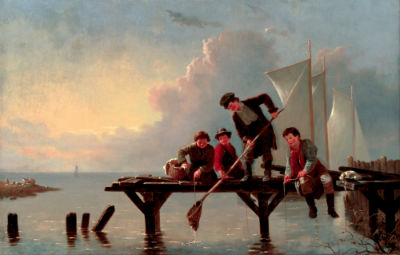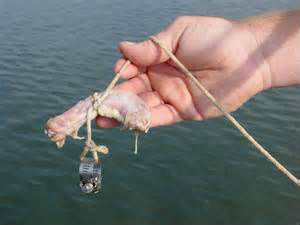 American artist William Ranney painted his “Boys Crabbing” in 1855. Source: Google Arts Project |
This is part a monthly series about the food of the N.C. coast. Our Coast’s Food is about the culinary traditions and history of N.C. coast. The series covers the history of the region’s food, profiles the people who grow it and cook it, offers cooking tips — how hot should the oil be to fry fish? — and passes along some of our favorite recipes. Send along any ideas for stories you would like us to do or regional recipes you’d like to share. If there’s a story behind the recipe, we’d love to hear it.
What do you need for a successful crab boil?
A dip net, a piece of string, a chicken neck and a nickname, that being “chicken-necker.”
Supporter Spotlight
It means you’re an amateur crabber, but who cares. Take your meager gear to a river, sound, creek or waterway on the N.C. coast for a few hours and you’re likely to catch enough crabs to feed a crowd.
“As long as we’re walking, we’ll be crabbers,” Barbara Thornton says.
The Ohio resident and her family visit North Carolina’s central or southern coast nearly every summer. Catching crabs, an activity better known as crabbing, is usually on the agenda.
Thornton and her late husband, John, learned to love blue crabs at steam shacks in Maryland, but the Ohio couple learned to catch crabs from an old salt on Oak Island.
A woman who lived next door to the cabin where the Thorntons stayed in the summer of 1974 showed the pair and their children how to tie a fish head and a small weight to the end of a long string. She took them to marshy, shallow waters at low tide and told them to throw the tied up fish head in the water while keeping a hold on the other end of the string.
Supporter Spotlight
When the string started to vibrate just a little bit, it meant a crab was nibbling the bait. From there, one Thornton pulled the string in slowly while another waited with a dip net. When the crab was visible near their feet, the netter scooped up the catch and dropped it in the cooler.
The family used fish heads until someone told them that chicken necks were better. Truly, a crab is not fussy, Cape Fear-area commercial crabber Scott Rader said.
 Here’s the decidedly low-tech rig used by chicken-neckers: cotton string, a fishing weight and, of course, a chicken neck. |
“A crab is like a buzzard,” he said. “It will eat anything.”
Chicken-neckers who crab the shallows use their coolers to gauge the tides. They arrive at low tide and set their coolers on a dry shore. When the cooler starts to float, it’s time to go home and eat the catch.
Back in the kitchen, the adventure isn’t over. Getting crabs into the steam pot may have some consequences.
“There were some fingers nipped,” Thornton said.
Long metal tongs are handy for mastering the little beasts. Keeping live crabs in a cold cooler will calm them, Radar advised.
While folks call cooking a mess of crabs a “crab boil,” the term isn’t accurate when it comes to preparing crabs, Radar said.
“You don’t want to boil them. You don’t want to cover them in the water,” he said. “Start the pot cold, steam them about five minutes, then let the pot sit for another 10 minutes. The meat will come right out of the shell. They’re perfect.”
The Thorntons layer crabs with Old Bay seasoning in a large stockpot with a little water, vinegar and beer in the bottom. They steam the crabs for about 30 minutes.
The crabs are placed in bowls and set on the table, where some members of the Thornton clan pick the back fin meat and leave the table after an hour.
“There’s always the handful of people who will stay at the table for hours,” Mrs. Thornton said.
Her husband was one of them, and he once explained why: “Some people just open the crab up and pick out the big pieces. They are the people who leave the table in an hour. I think the person who really knows them is in there picking out all the little morsels, just in a euphoria.”
Chicken-Necking 101
 Get some string: Cut medium-weight cotton or nylon string into 15- to 18-foot lengths. Tie a 1-ounce fishing weight to one end of each piece of string.
Get some string: Cut medium-weight cotton or nylon string into 15- to 18-foot lengths. Tie a 1-ounce fishing weight to one end of each piece of string.
Buy a pack of chicken necks: Tie a chicken neck on each piece of string near the weight. Tightly wrap the string around the chicken a few times, and tie tight knots to hold the bait. Crabs are strong. They’ve been known to pull a diamond right out of an engagement ring.
Hit the shallows: Crabbing is best at low tide, though you can catch at any tide level. Throw the baited end of the string as far into the shallows as possible or drop it off the end of a dock. Hold the string, loop it around your arm or tie it to a dock post. When you feel a nibble on the end of the line or the tied line is pulled out straight and tight, gently and slowly pull the line up. Pull too fast and the crab will flee.
Bring a dip net and a friend: When the crab is just visible beneath the water as you’re pulling the string, let your partner place the net in the water a good distance from the crab. The netter must be stealthy, quietly moving the net under the crab and scooping it up. Choose a dip net with a handle no more than 6 feet long. The handle must be long enough to reach below the crab on the line but short enough that it is easy to use.
Don’t forget the cooler: Turn the net over the open cooler and gently shake to deposit the crab into the box. If the crab becomes tangled, set the net down for a minute. The crab will settle. Alternately, don heavy rubber gloves and use your hands to remove the crab from the net. Grab the crab behind its flat paddle fins. Keep a loose cover over the cooler so the crabs can get air.
Know and follow the rules: Throw back small crabs and pregnant females. If a crab’s belly is swollen with an orange-yellow mass that darkens to black, the crab is pregnant.
North Carolina rules prohibit taking crabs less than 5 inches long across the pointed tips on their top shells. The size limit for females increases to 6¾ inches Sept. 1 to April 30. To learn how to identify male and female crabs, visit the N.C. Division of Marine Fisheries blue crab page.
Chicken-neckers do not need permits. Individuals may take up to 50 crabs a day. If they are on a boat, the catch limit is 100 crabs per vessel per day.







